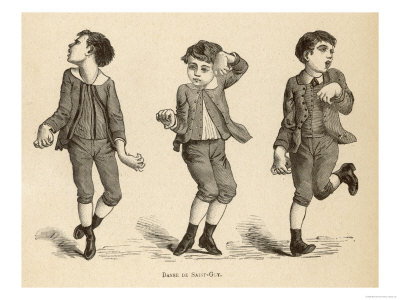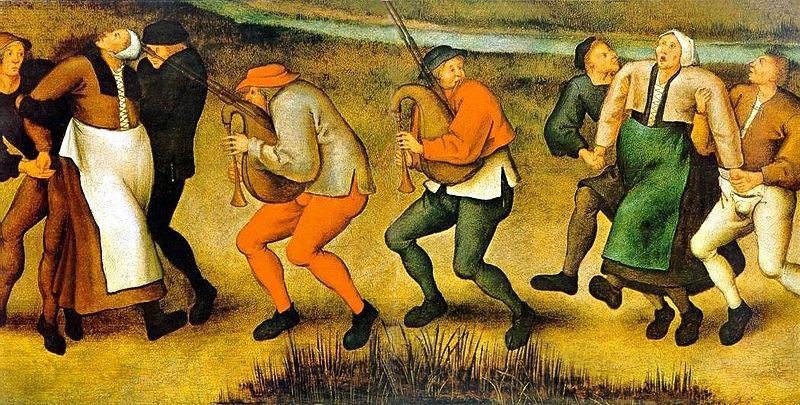 In the true spirit of the Wikiworm Manifesto I decided this week to look into St Vitus’ dance, which I had previously always thought to be a term for epilepsy. Turns out I was wrong again…
In the true spirit of the Wikiworm Manifesto I decided this week to look into St Vitus’ dance, which I had previously always thought to be a term for epilepsy. Turns out I was wrong again…
St. Vitus’ Dance was a social phenomenon that occurred in mainland Europe between the 14th and 17th centuries. The term was coined by Paracelcus, and the condition was initially considered a curse sent by St Vitus. It involved groups of people dancing in a mania for long periods, and affected men, women, and children, who danced until they collapsed from exhaustion. Generally occurring in times of hardship, up to tens of thousands of people would appear to dance for hours,days, weeks, and even months.
The earliest known outbreak of dancing mania occurred in the 7th century, and it reappeared many times across Europe until about the 17th century, when it stopped abruptly. Although numerous incidents were recorded, the best documented cases are the outbreaks of 1374 and 1518, for which there is abundant contemporary evidence.
Women have often been portrayed in modern literature as the usual participants in dancing mania, although contemporary sources suggest otherwise. Whether the dancing was spontaneous, or an organised event, is also debated. What is certain, however, is that dancers seemed to be in a state of unconsciousness, and unable to control themselves.
Such people would often travel from place to place, and others would join them along the way. They hardly stopped, and some danced until they broke their ribs and subsequently died. Throughout, dancers screamed, laughed, or cried, and some sang. Generally, musicians accompanied dancers, to try and counteract the mania, but this tactic sometimes backfired by encouraging even more people to join in.

Participants demonstrated odd reactions to the colour red, and it has also been noted that dancers “could not stand pointed shoes”, and that some enjoyed their feet being hit. Throughout, those affected by dancing mania suffered from a variety of ailments, including chest pains, convulsions, hallucinations, hyperventilation, epileptic fits,and visions. In the end, most simply dropped down, overwhelmed with exhaustion.
Numerous hypotheses have been proposed for the causes of dancing mania, and it remains unclear whether it was a real illness or a social phenomenon. One of the most prominent theories is that victims suffered from ergot poisoning, which was known as St Anthony’s Fire in the Middle Ages. During floods and damp periods, ergots were able to grow and affect rye and other crops. Ergotism can cause hallucinations, but cannot account for the other strange behaviour most commonly identified with dancing mania.
Other theories suggest encephalitis, epilepsy and typhus, but as with ergotism, those conditions cannot account for all symptoms. Numerous sources discuss how dancing mania may have simply been the result of stress and tension caused by starvation and natural disasters around the time,such as plagues and floods. Hetherington and Munro describe dancing mania as a result of “shared stress”; people may have danced to relieve themselves of the stress and poverty of the day, and in so doing, attempted to become ecstatic and see visions.
It is certain that many participants of dancing mania were psychologically disturbed, but it is also likely that some took part out of fear, or simply wished to copy everyone else. Sources agree that dancing mania was one of the earliest-recorded forms of mass hysteria, and describe it as a “psychic epidemic”, with numerous explanations that might account for the behaviour of the dancers.
It is interesting to draw a connection between the medieval St Vitus mania and the current hit youtube meme doing the rounds – The Harlem Shake – where groups of people post videos of themselves dancing in a crazed frenzy…











Fascinating post. Do you think it can be explained along the same lines as Tulipomania or the Internet Bubble?
Or the Magdalene laundry system, perhaps?
…or the way that sometimes someone laughing or yawning becomes contagious…
The key to this is the Medieval mind, which, of course, was entirely different from our own. A zealous religious belief, not disimilar, now I think of it, of modern day evangelists “speaking in tongues”.
My mother often told me I had St Vitus’ dance. Thanks to your post, Worm, I now realise it may be due to my incessant playing of a made-for-children recording of The Red Shoes (on red vinyl too!)
Would that be a children’s version of the Powell and Pressburger film of the same name Susan, or a version of the original Hans Christian Andersen story? Either way I guess it was ballet?
It was the Hans Christian Andersen story, Worm – there was a narrator, but it was mostly very tragic sounding music (I don’t think it came from the ballet score, though I may be wrong).